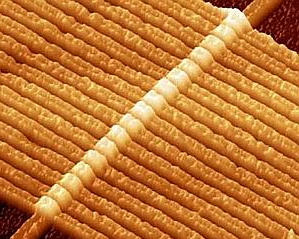 What are the 'Memristors'?
What are the 'Memristors'?"Memristor" or a "Memory Resistor" is the latest type of an electrical circuit which maintains a stable flow of electricity in a circuit by working as a resistor and maintains the charge due to the loss of power by working as a capacitor. It is speculated to potentially replace flash memory in computers which will make them more efficient in power consumption, faster speed and cheaper technology. It can be imagined as a circuit through which when the current flows in one direction, it expands making it less resistive. But when the same current flows in the opposite direction, it shrinks making it more resistive. It remembers its diameter whenever last current passes through. So when you turn off the current, memristor freezes its diameter until current is again turned on. That ability to store the resistance for an indefinite period makes the memristor work as a nonvolatile memory in computers.
Why 'Memristors' are useful?
Memristors remember information on a permanent basis and can switch in nanosecond making it super fast and power efficient so as to act as potential replacement for DRAM, flash, and disk in the future. Our Technology Expert at SpinxWebDesignNewYork.com says, this is due to the fact that Memristors have the power and speed of the RAM and the life of a hard disk. Not only DRAM, disk and flash, memristors are also expected to replace CDs and DVDs in the future as it is considered to be a universal non-volatile memory which has a lifetime more than that of a flash, and still in the expanding phase.
Specifications
Memristors require a system redesign as it is not a plug and play compatible technology. It just won't take a memristor chip or RAM module to make it work. Memristor is a technology which allows multiple crossbar memories stacked on top of each other. This allows multiple terabytes (preciously 128TB which is equal to 1PB (petabyte)) to occupy one square centimeter of space. Just imagine a huge amount of power stored efficiently in a small space. Memristors naturally implement material implication logic, which interconnects various other electrical components to create any logical operation, and that's why it can also act as a CPU.
See Also : In - Depth About Magento Widgets
Memristors have got the capability to decide whether to use some block as a memory, a switching network, or logic. When memristors dynamically change between memory and logic operations, it enables calculations to be performed simultaneously with the storage of data instead of occupying a special space in CPU. HP (Hewlett Packard) has already created a prototype of memristor way back in 2008 and as per latest updates it might take HP to make memristors to be made commercially available by 2014 as they have started to work on building the memristors which will consume lower power, have a more durable life, are smaller in size and faster in performance.
Capacity
With storage capacity in petabytes (128TB) and collocated CPU and data, memristors resemble a large cluster compacted in a small sized device just like a whole data center in the form of a brick. So what we have is a purpose device that can handle small to large data input sizes, small to large output sizes, and small to large computational demands. If your database fits in RAM by partitioning across multiple boxes, and if you have got enough processing power to handle your application combined with enough bandwidth to move your data around, then RAM could already act as your new disk. In a memristor, features of the RAM, flash, and disk are all unified and databases are also stored effectively.
Benefits With memristors, you have large quantities of data directly accessible to the CPU. Memristors can configured CPUs too which results in computation and data. Memristors have an ability to configure the memory dynamically with the help of logic devices and so it's perfect to apply functions to the data as configurations work in parallel. Memristors are useful in building highly integrated low power devices eliminating the risk and expense in creating ASICs as the current sensor devices are too cumbersome, expensive, and use ample power.
Conclusion
In case of memristors, writing applications will give developers a low cost benefit and the ability to build scalable applications, by remaining independent and looking for new opportunities. Will memristors make it possible to create highly integrated devices that will take fewer parts to build and consume low power? Memristors could revolutionize the technology of embedded systems in terms of its applicability.
No comments:
Post a Comment